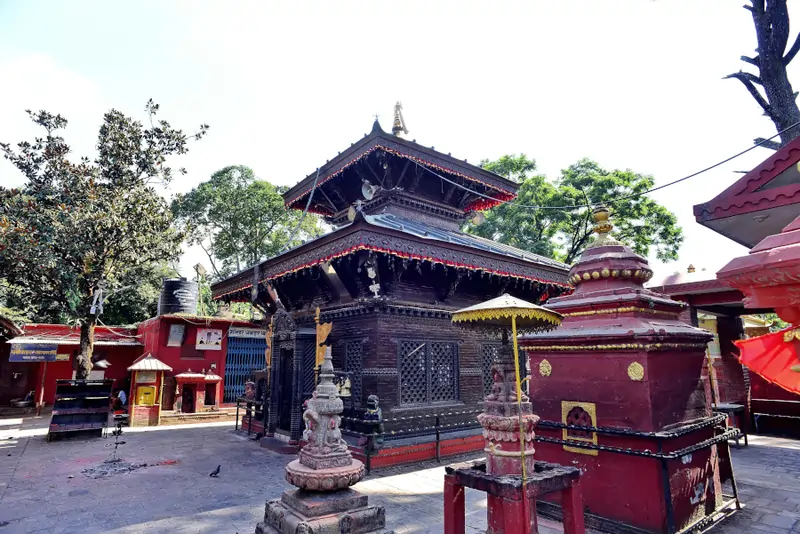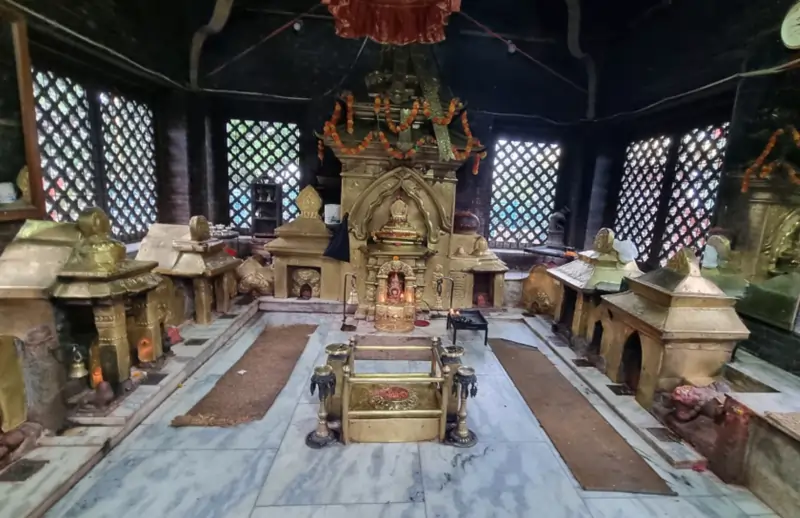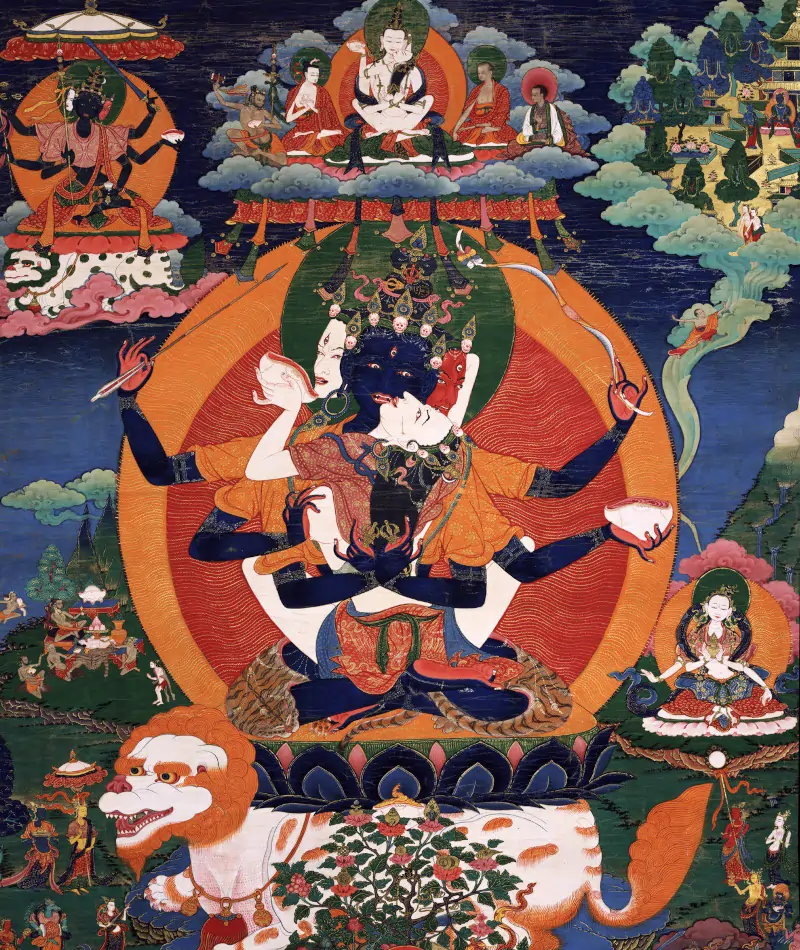Introduction: A Glimpse into Nepal’s Spiritual Heart
Nestled in the heart of the Himalayas, Nepal is a land steeped in spiritual tradition and mysticism. Among the myriad of deities worshipped in Newar Buddhism, two figures stand out with their profound symbolism and rich mythology: Yogambara (योगाम्बर) and Jnana Dakini (ज्ञान दाकिनी), collectively also known as Mhepi Ajima (म्हयपी अजिमा) or Yogambara Gyaneswari (योगाम्बर ज्ञानेश्वरी). They are closely associated with the teachings of the Chaturpita Tantra. Mhepi Ajima holds a special position among the Newar community, widely worshipped as the Kul Devata (कुल देवता), the principal deity of the family. This veneration reflects her integral role in the spiritual lives of the Newars, underscoring her importance in their cultural and religious practices.
Yogambara: The Majestic Protector
Yogambara, in Sanskrit योगाम्बर, emerges as a deity of great reverence and power. In Newar Buddhism known also as Mhepi – म्हयपी, he stands as a symbol of protection and spiritual strength. Regarded as a fierce protector, Yogambara is often depicted in the pantheon of Vajrayana Buddhism, particularly within the Newar Buddhism traditions. This deity is revered for his role in safeguarding the Dharma and assisting practitioners in overcoming obstacles on their spiritual path. Characterized by his intense and wrathful appearance, Yogambara symbolizes the transformation of anger and ignorance into wisdom and compassion, a core tenet in Buddhist teachings. His imagery, often rich with symbolic elements, serves as a powerful reminder of the inner strength and determination required for spiritual progress. Yogambara is one of the most popular Vajrayana deities of Newar Buddhism.
The Visual Splendor of Yogambara
In the vivid and symbolic world of Newar Buddhism, the visual representation of Yogambara is both striking and profound. He is depicted with three distinct faces, each a different color – black, white, and red – symbolizing various aspects of the divine. These faces, each adorned with three eyes, convey the all-seeing nature of the deity, encompassing omniscience and spiritual insight. Yogambara’s six arms further exemplify his divine attributes and functions. In his first two hands, he holds a vajra and a bell, instruments that represent the union of wisdom and compassion. These hands also tenderly embrace his consort, Jnana Dakini, signifying the harmonious balance of male and female energies. On one side, his hands wield a skullcup and a bowl, echoing themes of impermanence and spiritual nourishment. Meanwhile, his other hands are engaged in an intimate gesture with Jnana Dakini, caressing her breast and holding an arrow, images that resonate with themes of fertility, creation, and the path of enlightenment. This intricate iconography of Yogambara is not just a testament to the artistic richness of Newar Buddhism but also a profound visual representation of its deep spiritual philosophies.
Jñana Dakini: The Embodiment of Wisdom
Jñana Dakini, known as the ‘Wisdom Dakini’, in Sanskrit ज्ञान दाकिनी, in Newar Buddhism also known as ज्ञानेश्वरी which is spelled in English as Jñānēśvarī or Jnanesvari or Gyaneswari, stands as a figure of profound wisdom and enlightenment. Known affectionately as Ajima – अजिमा in newari language, meaning great grandmother, she is revered as a manifestation of insightful understanding and spiritual guidance. Jnana Dakini, revered in Newar Buddhism as Ajima, embodies profound wisdom and serves as a guiding light in the spiritual journey. Her portrayal is not just a reflection of Nepal’s artistic heritage but also a symbol of Buddhism’s core philosophies, providing a window into the journey towards enlightenment and spiritual awakening.
The Enigmatic Jnana Dakini
Jnana Dakini, a revered figure in Newar Buddhism, is depicted with a captivating and complex visual representation. She possesses three faces, each a different hue – blue, white, and red – symbolizing varied aspects of her divine nature. These faces are further accentuated by three eyes each, indicating her all-encompassing awareness and insight. In a display of her multifaceted role, Jnana Dakini’s six arms each hold significant objects. The right set of hands grasps a katvanga staff, an axe, and a vajra scepter, representing her ability to cut through ignorance, her spiritual authority, and her indestructible nature. Conversely, her left hands hold a bell, a skullcup filled with blood, and a sword, symbols that resonate with her role in the spiritual liberation, the transformative power of wisdom, and the cutting away of delusion. This intricate portrayal of Jnana Dakini is not just a testament to the artistic depth of Newar Buddhism but also a vivid embodiment of the profound spiritual concepts she represents.
Recognizing Yogambara and Jnana
To recognize Yogambara and Jnana, observe that Yogambara is illustrated in blue, featuring multiple arms, and is shown embracing Jnana, who is depicted in white with a single head and standard arms and legs.
The Legend of Mhepi Ajima
The deities Yogambara and Jnana Dakini in Newar Buddhism also known Mhepi Ajima or Yogambara Gyaneswari, hold a place of profound reverence and daily significance. Their legend intertwines deeply with local lore and practices. As per the legend, Yogambara and his consort Jnana Dakini, in the forms of Yaksha and Yakshani, manifested in Kamarupa in Assam, where they birthed Lord Karunamaya, deity of compassion, also known as bodhisattva Avalokiteshvara. This divine lineage has led to the enduring tradition of Lord Karunamaya’s chariot festival, a significant and vibrant event still celebrated today in Patan city. During this festival, it is believed that Jnana Dakini, in her Yaksha form as the mother of Karunamaya, would make her presence felt at Lagankhel in Patan, observing the ceremonial bathing from atop a tree. This deep-rooted legend not only enriches the spiritual landscape of the Newar community but also integrates these deities into their daily life, weaving their reverence into the very fabric of their cultural and religious identity. The enduring nature of these traditions and celebrations highlights the enduring connection between the Newars and these powerful deities, symbolizing a continuum of faith and cultural heritage that spans generations.
Mhepi Ajima Temple in Kathmandu
Nestled atop a scenic hill in Mhepi Marg, Kathmandu, the Mhepi Ajima Temple, also known as the Yogambara Gyaneshwari Temple, is a revered site of worship and spiritual significance. This temple, dedicated to the divine figures of Mhepi Ajima, stands as a prominent destination for devotees and visitors alike. To reach this sacred place, one embarks on a short but invigorating uphill hike, journeying to the summit of the hill where the temple proudly resides. The ascent not only offers a physical challenge but also serves as a metaphorical journey towards higher spiritual understanding. Upon reaching the top, visitors are greeted by the serene ambiance of the temple, which offers a tranquil retreat and a panoramic view of the surrounding landscape. The Mhepi Ajima Temple, with its unique location and spiritual aura, continues to be a beacon of devotion and a testament to the rich religious heritage of Kathmandu. See in Map


Yogambara and Jnana Dakini in Practice
In Newar culture, the worship of Yogambara and Jnana Dakini is deeply integrated into daily spiritual practices. Far beyond mere artistic representations, their images in art and sculpture serve as vital focal points for meditation, devotion, and spiritual reflection. These deities are revered not just for their aesthetic appeal but for the profound virtues they embody. Yogambara, symbolizing protection and strength, and Jnana Dakini, epitomizing wisdom and enlightenment, play a crucial role in guiding devotees along their spiritual paths. Their presence in daily rituals and practices reflects the deep connection between the Nepalese people and these divine figures, highlighting a relationship that is both sacred and integral to their spiritual journey.
Chaturpita Tantra: The Fourfold Path of Vajrayana Buddhism
Chaturpita Tantra is an integral concept within Vajrayana Buddhism, offering a structured and comprehensive approach to spiritual advancement through four distinct types of tantric practices: Kriya, Charya, Yoga, and Anuttarayoga. This framework not only provides a progressive path towards enlightenment but also establishes a deep connection with two crucial deities in Vajrayana Buddhism: Yogambara and Jnana.
Kriya Tantra: The Path of Ritual Action
Kriya Tantra, the first of the four paths, emphasizes ritual actions and ceremonies. It involves elaborate rituals, purification practices, and devotional activities, focusing on external cleanliness and discipline as a means to purify the mind and body.
Charya Tantra: The Way of Conduct
Charya Tantra goes a step further, combining ritual actions with ethical conduct. This path stresses the importance of compassionate actions and moral behavior in daily life, integrating spiritual practice with ethical living.
Yoga Tantra: The Union of Meditation and Ritual
Yoga Tantra represents a more internalized approach. It blends meditation with ritual practices, focusing on visualizations, mantras, and complex symbolisms. This path aims to bring about a deeper understanding and realization of the self and the universe.
Anuttarayoga Tantra: The Supreme Vehicle
Anuttarayoga Tantra is the most advanced practice, involving esoteric and often secretive teachings. It includes advanced meditation techniques and philosophical teachings, aiming at direct realization of the ultimate nature of reality. This path is known for its potential to bring about rapid spiritual progress.
Yogambara and Jnana Dakini in Chaturpita Tantra
Yogambara and Jnana Dakini, as deities in Vajrayana Buddhism, play significant roles in the context of Chaturpita Tantra. They are often invoked in various practices across these paths, serving as embodiments of the principles each Tantra represents. Yogambara, with his protective and powerful nature, is particularly relevant in the practices of Kriya and Anuttarayoga Tantra. Jnana Dakini, embodying wisdom and enlightenment, is a central figure in all paths, guiding practitioners in their journey toward spiritual realization.
Conclusion: Embracing the Mystique of Mhepi Ajima
In conclusion, Yogambara and Jnana Dakini, also known as Mhepi Ajima, stand as emblematic figures of spiritual strength and wisdom in Newar Buddhism. Their intricate iconography and inspiring legends not only enrich the spiritual landscape of Nepal but also offer profound insights into the essence of Buddhist practice. Yogambara, with his formidable presence, exemplifies the determination needed to overcome inner challenges, while Jnana Dakini, radiating tranquil wisdom, illuminates the path to understanding reality’s true nature. Their combined attributes underscore a harmonious balance of power and wisdom, fundamental for spiritual growth. Delving into the teachings of these deities and the principles of Chaturpita Tantra, we uncover the multi-layered aspects of Buddhist philosophy. This exploration not only deepens our understanding but also guides us on a path toward enlightenment, highlighting the continuing relevance and inspirational power of Yogambara and Jnana Dakini in guiding practitioners toward spiritual fulfillment.
References
- The Iconography of Nepalese Buddhism, Min Bahadur Shakya, 1994
- DIGU PŪJĀ : LINEAGE GOD WORSHIP, Tina Manandhar, 2014
- Buddhist Deity: Yogambara, himalayanart.org
- Buddhist Deity: Jnana Dakini, himalayanart.org

